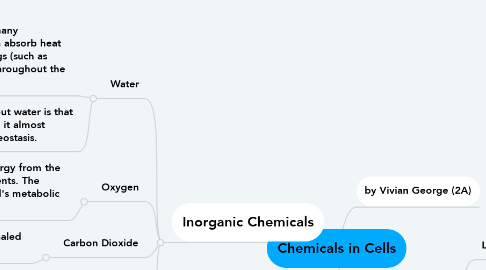
1. Inorganic Chemicals
1.1. Water
1.1.1. Important solvent because many substances dissolve in it. Can absorb heat and transfers important things (such as salts, sugars, and vitamins) throughout the body.
1.1.2. Another important thing about water is that it is resistant to heat, making it almost perfect for maintaining homeostasis.
1.2. Oxygen
1.2.1. Oxygen is used to release energy from the sugar glucose and other nutrients. The released energy drives the cell's metabolic activities.
1.3. Carbon Dioxide
1.3.1. Produced as a waste product and exhaled out.
1.4. Salts
1.4.1. Salts are important compounds that are composed of oppositely-charged ions. It provides ions through sodium, chloride, potassium, calcium, magnesium, phosphate, carbonate, bicarbonate, and sulfate processes.
1.4.2. They are also important to transportation in and out of cells, muscle contractions, and nerve impulse conduction.
2. Organic Chemicals
2.1. Lipids
2.1.1. insoluble in water -fats, phosoholipids, and steroids-
2.1.1.1. Fats, fatty acids, glycerol,
2.2. Carbohydrates
2.2.1. Provides essential energies for the body. Consist of atoms of carbon, hydrogen, and oxygen.
2.2.1.1. Sugars, monosaccharides,
2.3. Nucleic Acids
2.3.1. Forms genes and takes part in protein synthesis.
2.3.1.1. Nucleotides, DNA, RNA
2.4. Proteins
2.4.1. Wide variety of uses, like structural material, hormones and energy sources.
2.4.1.1. Receptors, antibodies, enxymes, amino acids,

